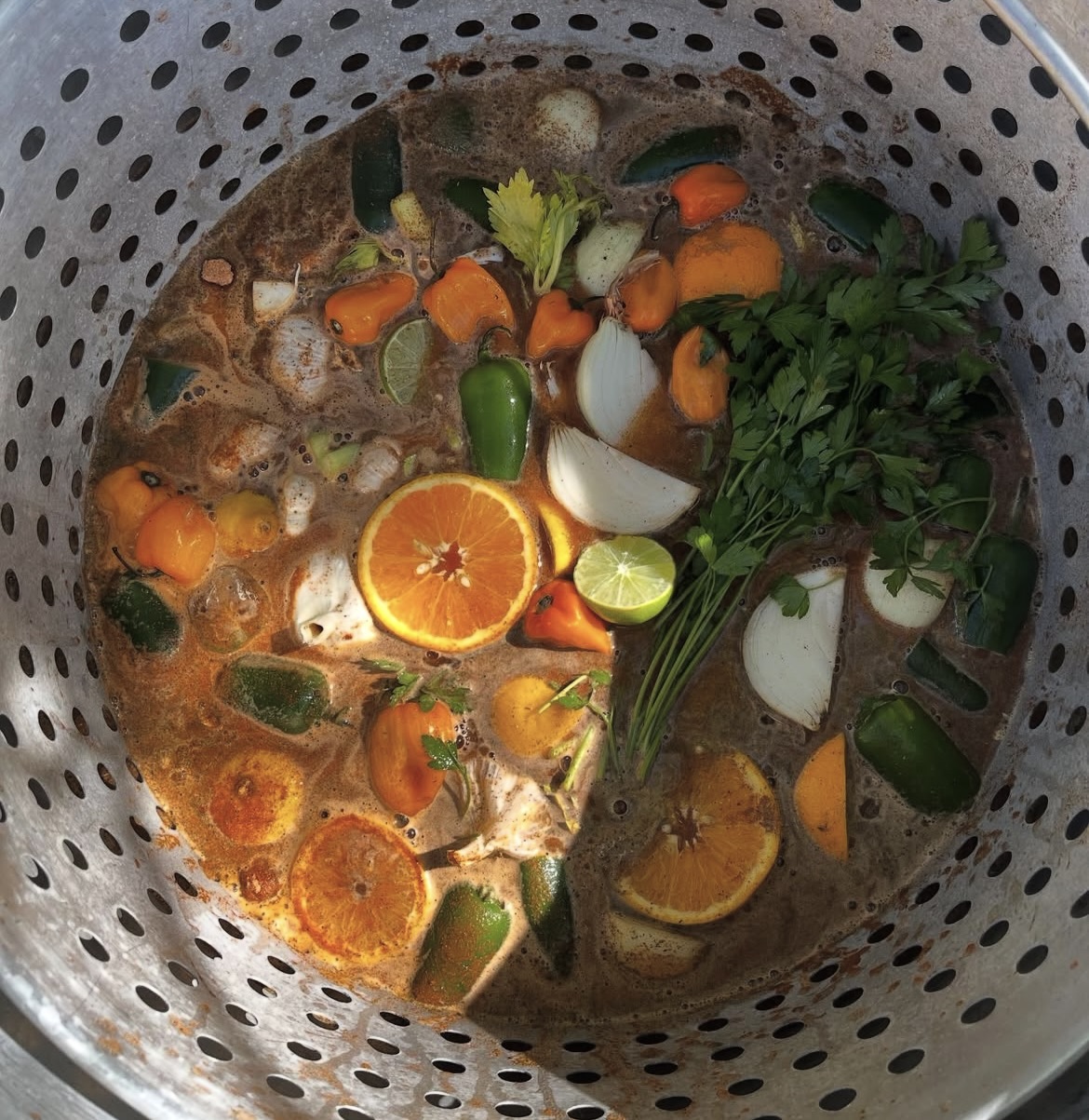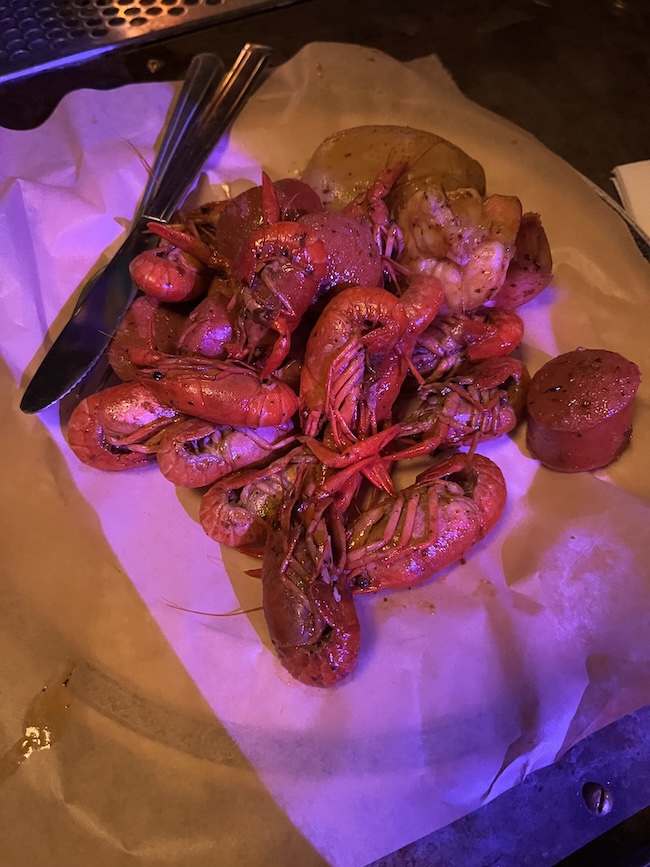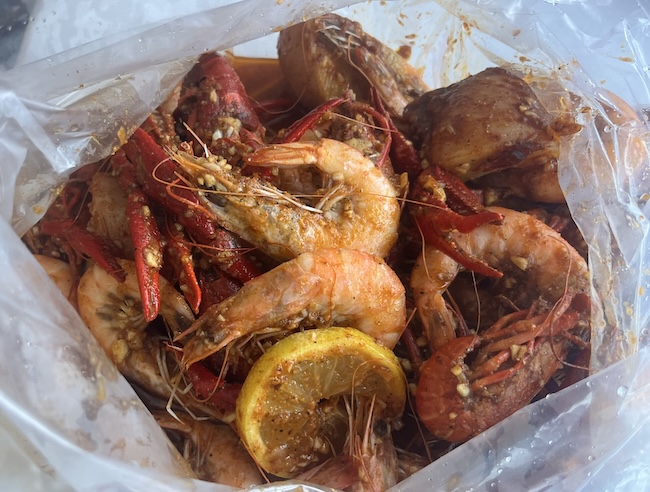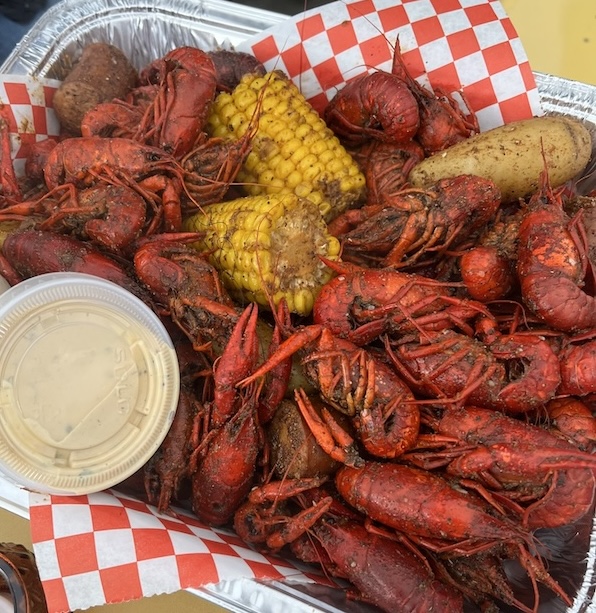Tempest in a Crawfish Pot: Birth and Rise of Viet-Cajun
By Romen Basu Borsellino | 24 Jul, 2025
The debate between traditional crawfish and Viet-Cajun encapsulates a half century of Vietnamese influence on the evolution of Houston’s cultural identity.
Residents in the state of New Mexico can largely be divided into two camps: Those who prefer red chile and those who go green.
In New England, you’ll either opt for a hot Maine-style lobster roll or its cold Connecticut counterpart.
And in Houston Texas, where crawfish is king, you can get your mudbugs one of two ways: “Traditional” or Viet-Cajun, the Vietnamese community’s twist on a culinary staple.
The rise of Viet-Cajun crawfish tells the story of innovation and resilience by a group of people who came to this country seeking refuge. It’s also the story of how heaps of garlic and butter can make anything taste even better.
History of Crawfish in Houston
Houston’s relationship with crawfish doesn’t actually stretch back that far. A few seafood restaurants in the mid-70s and early-80s offered crawfish boils once or twice a year, but interest never really went mainstream.
That changed in the 90s when a scarcity of Texas Blue Crab, caused largely by out of state fish markets snatching up available supply, made price and demand for the local seafood staple skyrocket. So, Houstonians turned to the most readily available shellfish: crawfish.
Of course, crawfish in the South is about more than just sustenance. The traditional boil is a social event held in backyards with friends and loved ones. The crustaceous red guests of honor have become synonymous with the white butcher paper that covers the folding tables, the plastic bibs placed over clothing, and the cold beer that washes everything down.
These crawfish boils are typically held between the months of January and July. Given Houston’s strong Catholic community, which accounts for about 30% of the population, it helps that the crawfish season encompasses Lent, the pre-Easter period when seafood consumption spikes.
Those hosting a boil typically keep crawfish in cold water — sometimes even in an inflatable kiddie pool — before throwing them into the bubbling pot with corn, potato, sausage, and various spices.
The Ragin’ Cajun in Houston, credited as the first restaurant to put Crawfish on their menu, proudly proclaims that their house recipe uses “cayenne pepper, black pepper, salt, garlic powder & chili powder.” The exact spices may vary, as may certain additions like celery and parsley, but those are more or less what one can expect at any traditional boil.

When the crawfish are ready, the pot is drained and the contents are poured directly onto the paper-covered communal tables. Diners dig in with their hand using the “peel the tail, suck the head” technique.
And that’s how crawfish in the South have been enjoyed for some time. That is, until…
The Fall of Saigon
In 1975 the Vietnam War ended with the collapse of Saigon, South Vietnam’s Capital. In both the immediate aftermath and ensuing years, hundreds of thousands of Vietnamese refugees fled to the United States, with tens of thousands ending up in Texas. Houston made sense as a destination for a number of reasons including a prominent Roman Catholic community that was involved in resettlement efforts and climate conditions that resembled those of South Vietnam.
Houston’s location along the Upper Gulf Coast was not unlike South Vietnam's proximity to the South China Sea. Many fleeing Vietnam had a background in fishing and maritime-related work that opened the door to employment opportunities in Houston’s seafood industry. New Orleans and the surrounding Bayou became the second most popular resettlement destination for the same reasons.
Swaths of Louisiana and Houston’s populations converged in 2005 when Hurricane Katrina forced many New Orleans residents to flee. For the Vietnamese, this meant yet another forced re-location. The established Vietnamese community just five to six hours away made Houston an easy destination.
Years later, BP’s Deepwater Horizon spill dumped 4.9 million barrels of oil into Louisiana's water, which decimated the livelihood of fishermen in that part of the Gulf and provided yet another reason for Vietnamese residents to relocate to Houston.
In the fifty years since Saigon fell, Houston has become home to roughly 100,000 Vietnamese. Prior to 1975, there were fewer than 1,000 Vietnamese living there.
And 80% of Vietnamese people along the Gulf Coast work in the seafood industry. Vietnamese account for one-third of all Gulf Coast fishermen.
This is all to say that the Vietnamese community is firmly intertwined with the Gulf’s seafood scene. It is nearly impossible to talk about one without the other. Therefore, Vietnamese contributions to the cuisine in the area should come as no surprise.
Viet-Cajun Crawfish
Viet-Cajun crawfish is the name given to a style of crawfish that includes Vietnamese spicing in the preparation and is served with dipping sauces that do not typically accompany traditional crawfish. But beyond that, some of the details of what constitutes Viet-Cajun are up for debate.
In many ways, there was already little daylight between Cajun and Vietnamese food. Just compare a banh mi to a po boy, a bowl of pho to a pot of gumbo or any of the two cultures’ many dishes that are centered around rice and spicing.
But when it comes to crawfish, the roots of Viet-Cajun style can be traced back to about 2001. Restaurant critic Robb Walsh of the Houston Press was one of the first to describe what he observed to be a Vietnamese twist on the Houston staple. In a 2002 article titled “Asian Cajun” he wrote about a visit to Houston’s Hong Kong City Mall in Chinatown: “On this Saturday afternoon, Cajun Corner is jumping. Almost every table is occupied, and almost everyone seems to be speaking Vietnamese."
What differentiated these crawfish from the traditional style had nothing to do with the preparation, but simply the fact that they were served with a dipping sauce. “Atop the long crowded tables covered in protective paper sat different combinations of dips, sauces, and spices for patrons to mix together.” Walsh observed “Lemon wedges, squeeze bottles of ketchup and mayonnaise, Louisiana hot sauce, salt and pepper mixed together and lots of pure ground cayenne…."Is that a dipping sauce for the crawfish?" I ask him in disbelief.”
But while Walsh was intrigued by this discovery, he was not ready to declare a whole-scale transformation of the dish.
Simply adding a dipping sauce to something doesn’t exactly seem like a dramatic change, right? Do my french fries become a different dish when I dunk them in ranch? On the other hand we have different names for a french dip and a roast beef sandwich simply because of the sauce.
As it turns out, Viet-Cajun would come to refer to more than just the sauces added after the crawfish were made.
Walsh re-visited the topic in a follow-up piece nine years later, asserting that “When I wrote about Asian-Cajun crawfish back in 2002, there was very little difference between the Vietnamese and the Cajun version…It's fair to say that Vietnamese crawfish restaurants have developed their own unique style.”
It is near-universally understood that that style involves tossing the crawfish in melted butter and garlic. Lemon grass may make an appearance as well, along with fish sauce, and of course the standard ingredients of a traditional boil.
As the New York Times wrote in 2020, “The style expands the flavor profile of traditional South Louisiana whole boiled crawfish, with modified spice blends and a twist developed by Vietnamese-American chefs: a generous bath in seasoned butter sauce.”
It’s safe to assume that few members of the general public were venturing to the Hong Kong City Mall food courts or reading food blogs like Robb Walsh’s. Therefore, many give credit for the popularity of Viet-Cajun crawfish to Chef Trong Ngyuen, whose Houston restaurant “Crawfish and Noodles” opened its doors in 2008.
Per the New York Times, “The restaurant, in a district known as Asiatown, is arguably Houston’s best-known purveyor of Viet-Cajun crawfish.”
While the restaurant now commonly tops lists of Houston’s must-trys — and has even made Nguyen a James Beard award finalist — Nguyen described the pushback he received from customers when his restaurant was first getting started: “They say, ‘This is not how you cook the crawfish,’” he said. “I’d say: ‘I don’t cook Louisiana crawfish. It’s Vietnamese crawfish. My style is different.’”
Order of Operations

As with any type of food, there is no single all-encompassing rule that dictates how Viet-Cajun crawfish should be prepared. While it is generally agreed upon which types of spices make up this style of crawfish, there is less of a consensus when it comes to the order in which they are added.
Some have asserted that one main difference between Viet-Cajun and traditional cuisine lies in the boiling. Traditional preparation involves boiling the crawfish in the spices themselves. Many believe that Viet-Cajun preparation does this as well, but with the added step of tossing the crawfish in garlic and melted butter after they come out of the water.
Per an article published in Food Republic, “Viet-Cajun involves a myriad of ingredients, such as garlic and oranges and other aromatics, which are added to the boil to enhance the flavor of the crawfish flesh, and is finished off with a toss of garlic butter on the outside shell.”
But others disagree with this assessment, claiming that in the Viet-Cajun tradition, it is not just the melted butter and garlic that are added after the crawfish are boiled, but all seasoning and spices as well.
As Jeanne Lyons Davis of Houstonia Magazine describes, “Instead of seasoning the water with salt, pepper, cayenne and garlic salt as in most traditional Cajun boils, Vietnamese crawfish are often seasoned after, topping the hot-from-the-pot crawfish with a fragrant and buttery mess.”
Consumers have their own opinions on which style is better. Speaking with the New York Times in 2010, Chef Hieu Pham made the case for boiling the crawfish in the seasoning rather than just adding it afterwards: “I want my flavor to be in the crawfish meat. Not on the shell. You’re not supposed to get the flavor when you lick your fingers.”
Present Day
In 2017, just 16 years after Robb Walsh had first observed a Vietnamese twist on crawfish, the Houstonian food expert declared that “The Vietnamese crawfish craze” had become so dominant that “In fact, many younger locals have little memory of eating Cajun-style crawfish.”
Whether or not that’s true, there is little doubt about the extent to which the Vietnamese have left their mark on Houston’s food scene. Beyond the Gulf, Viet-Cajun restaurants like The Boiling Crab are even popping up all over Southern California, which tops Houston for the largest Vietnamese population in the country. In fact, Viet-Cajun crawfish has even gone full circle and made its way to Vietnam.

In some ways, the crawfish debate pits the traditionalists against the innovators. Yes, there are those who like their crawfish the more classic way. But much like some music fans prefer the Jimi Hendrix cover of “All Along the Watchtower,” to Bob Dylan’s original version, many see the Viet-Cajun style as an improvement on an already-good thing.
In a recent episode of “Ugly Delicious” on Netflix, Chef David Chang traveled to New Orleans to spotlight the cuisine. He highlights an aversion to the Viet-Cajun style on the grounds that “the way it’s always been done is superior.” But Chang disagrees. “Who cares about tradition, let’s just make it delicious.”
The elephant in the room that Chang does not explicitly mention here is an aversion to Viet-Cajun due to xenophobia. Of course, the traditional crawfish style itself is born out of Creole culture, so who gets to say what is American and what isn’t?
Then again, maybe it’s just about garlic and butter.
The rise of Viet-Cajun crawfish tells the story of innovation and resilience by a group of people who came to this country seeking refuge. It’s also the story of how heaps of garlic and butter can make anything taste even better.

Asian American Success Stories
- The 130 Most Inspiring Asian Americans of All Time
- 12 Most Brilliant Asian Americans
- Greatest Asian American War Heroes
- Asian American Digital Pioneers
- New Asian American Imagemakers
- Asian American Innovators
- The 20 Most Inspiring Asian Sports Stars
- 5 Most Daring Asian Americans
- Surprising Superstars
- TV’s Hottest Asians
- 100 Greatest Asian American Entrepreneurs
- Asian American Wonder Women
- Greatest Asian American Rags-to-Riches Stories
- Notable Asian American Professionals

